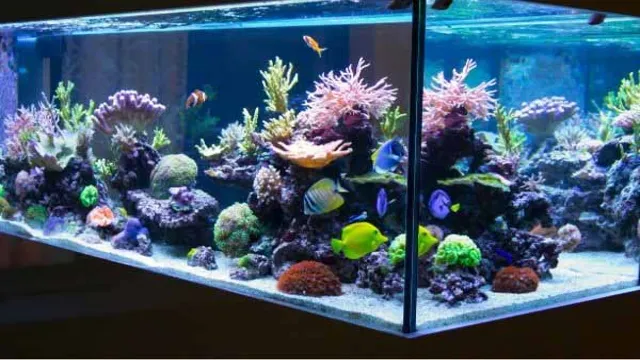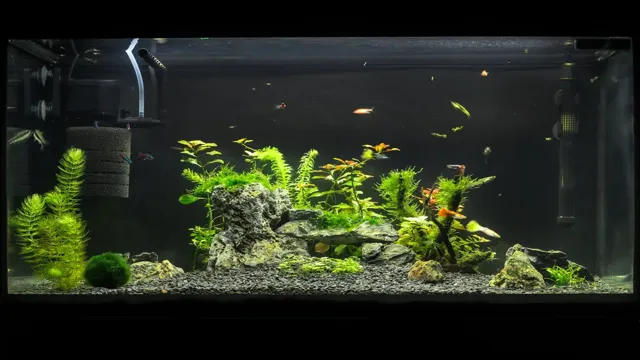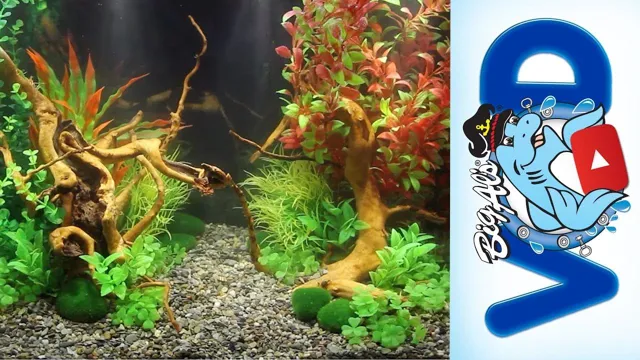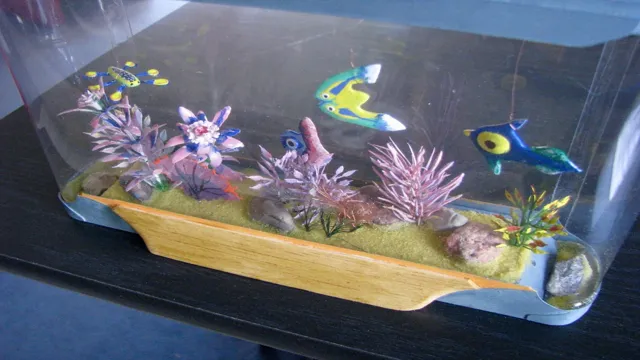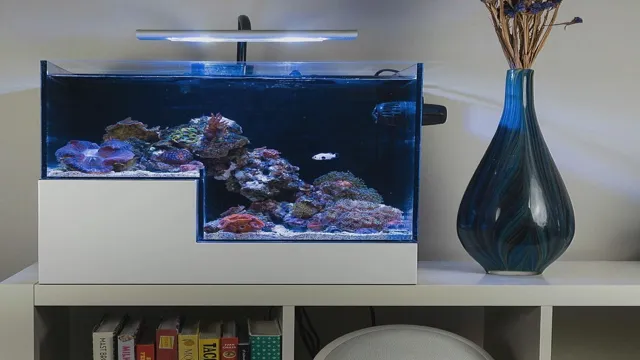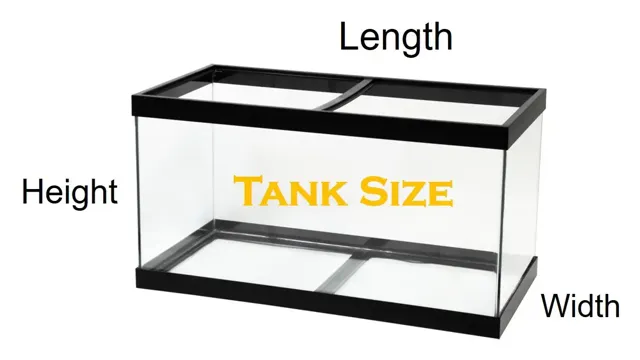Are you planning to set up a saltwater aquarium but don’t know where to start? One of the most crucial aspects of having a thriving marine life ecosystem is providing clean and healthy water. To achieve this, you need to learn how to make water for your saltwater aquarium. Making water for your saltwater aquarium involves properly mixing salt and reverse osmosis (RO) water.
The use of RO water ensures that all impurities, such as chemicals and minerals, are removed, leaving behind only pure water that can support the aquatic life in your tank. However, getting the right balance of salt and water can be challenging, and there are a few things you need to keep in mind. For instance, you must always measure the salt and water precisely and gradually mix them to avoid stressing your marine creatures.
Additionally, you need to maintain the correct salinity levels, which is important for the survival of your saltwater aquarium inhabitants. Regular testing is crucial to ensure that your water has the appropriate levels of pH, ammonia, nitrite, and nitrate to achieve a healthy environment for your aquatic animals. In conclusion, making water for your saltwater aquarium is a crucial step to ensure that your marine creatures thrive.
With the right tools and knowledge, anyone can learn how to make clean and healthy water for their saltwater aquarium. Let’s get started!
Why Water Quality Matters
For any saltwater aquarium enthusiast, maintaining proper water quality is crucial to the health and survival of the marine life in the tank. But how exactly do you make water for a saltwater aquarium? The first step is to use a high-quality synthetic sea salt mix and mix it with purified water. It’s important to make sure the mixing container and stirring utensils are clean to avoid any contamination.
Once the salt mix has been dissolved, it’s vital to test the water’s salinity, pH, and temperature using a reliable testing kit. Adjusting these parameters with the appropriate water additives ensures that the water is optimal for the marine life in the aquarium to thrive. Remember, even the slightest imbalance in water quality can have devastating effects on your saltwater aquarium, causing stress, disease, and even death to your marine life.
By carefully monitoring water quality and taking the necessary steps to maintain it, you can create a thriving and beautiful saltwater aquarium to enjoy for years to come.
Ensuring Proper Salinity
Proper Salinity in Your Aquarium Water quality plays a vital role in the success of any aquarium. One important aspect of maintaining water quality is ensuring proper salinity levels. Salinity refers to the amount of salt in the water, and it can have a significant impact on the health of your fish and other aquatic creatures.
Saltwater species require a higher salinity than freshwater species, but too much salt can be harmful to all types of fish. To ensure proper salinity in your aquarium, it’s important to test the water regularly and make adjustments as needed. Different species have different salinity requirements, so it’s important to do your research before adding any new fish to your tank.
Investing in a quality salinity meter is a great way to ensure accurate readings and maintain a healthy environment for your aquatic pets. Remember, proper salinity is just one factor in maintaining water quality, so be sure to also monitor other parameters such as pH, ammonia, and nitrate levels.

Removing Impurities
When it comes to water, quality matters more than we often realize. Impurities present in water can pose a significant threat to human health. It’s important to keep in mind that even seemingly clear water can contain impurities that are harmful to us.
These impurities vary from bacteria and viruses to toxic chemicals and heavy metals. Drinking contaminated water can result in serious illnesses, such as gastrointestinal diseases, liver damage, or kidney problems. Therefore, removing impurities from water is crucial to ensure safe drinking water.
It’s like purifying gold. If we leave impurities out, the gold won’t be as valuable. Similarly, if we ignore impurities in water, it won’t be as valuable to us either.
That’s why water quality matters, and we must remove impurities to protect ourselves and our loved ones.
Materials You’ll Need
If you want to set up a saltwater aquarium, it’s important to know how to make water that is safe for your fish and other marine life. To get started, you will need to gather a few materials. You’ll need pure water, which can come from a reverse osmosis filtration system or distilled water.
You will also need synthetic sea salt mix, which you can purchase online or at a pet store. Additionally, you will need a thermometer to monitor the temperature of the water, as well as a hydrometer or refractometer to measure the salinity of the water. Mixing the salt and pure water together can be done in a large container or a mixing bucket.
Once you have the correct salinity and temperature, your water is ready for your saltwater aquarium. With these materials on hand, you can create a perfect environment for your marine life.
Clean Water Source
When it comes to finding a clean water source, there are a few materials that are essential to have on hand. First and foremost, a water filter is crucial in removing any harmful pollutants or bacteria from the water. There are a variety of filters available, including straw filters, pump filters, gravity filters, and more.
Additionally, a reliable water bottle is important for transporting clean water once it has been filtered. It’s also a good idea to have a water treatment solution, such as iodine tablets or chlorine drops, on hand in case of emergencies. Finally, a sturdy water container, such as a collapsible water bladder or jerry can, can come in handy for transporting larger quantities of water.
By having these materials on hand, you’ll be better equipped to find and maintain a clean water source, no matter where your travels take you. (See Also: How to Create a Self Cycling Aquarium Ecosystem: A Step-by-Step Guide)
Marine Salt Mix
If you’re thinking about creating an ocean-like environment for your aquarium, you’ll need to prepare your own marine salt mix. Doing so can seem like a daunting task, but it’s actually quite simple. The first thing you’ll need is a container for mixing the salt, such as a large plastic bucket.
You’ll also need a scale to measure out the salt, a stirrer or powerhead to mix the salt and water together, and a hydrometer to measure the salinity of the water. Additionally, you’ll need to purchase high-quality marine salt mix that contains all the necessary minerals and trace elements for a healthy marine environment. Look for a brand that is specifically formulated for reef aquariums, as these tend to contain higher levels of important elements such as calcium, magnesium, and strontium.
It’s also important to follow the manufacturer’s instructions carefully when mixing the salt, as the ratio of salt to water can vary depending on the brand. Creating your own marine salt mix can be a rewarding process that ultimately results in a thriving marine environment for your aquarium inhabitants. By ensuring you have all the necessary materials and following the instructions carefully, you’ll be well on your way to providing your aquarium with the perfect balance of minerals and trace elements, allowing your marine creatures to thrive.
Aquarium Thermometer
If you’re a fish enthusiast, then you know that maintaining the right temperature in your aquarium is vital for your fish’s overall health. Investing in an aquarium thermometer is an affordable and efficient way to keep an eye on the temperature levels. Here are the materials you’ll need to make your own aquarium thermometer: a thermometer, suction cup, and adhesive.
You can easily find these materials at your local pet store or online. A thermometer that measures the temperature in Fahrenheit or Celsius is ideal. Make sure the suction cup is strong enough to hold the weight of the thermometer.
Adhesive is also essential to ensure the thermometer sticks to the inside of the aquarium glass, making it easy to read. With these materials, you can quickly and easily create your own aquarium thermometer, ensuring your fish are comfortable and healthy.
Powerhead or Air Pump
When it comes to aquariums, there are plenty of options to choose from when it comes to keeping the water oxygenated. Two of the most popular options are the powerhead and the air pump, but how do you know which one is the best for your tank? First, let’s talk about what each one does. A powerhead is a device that attaches to the side of the tank and circulates the water using a propeller.
It not only adds oxygen to the water but also creates currents that help keep the water moving and fresh. On the other hand, an air pump pumps air into the water, which creates bubbles and therefore agitation on the surface of the water. So, which one should you choose? It ultimately depends on the needs of your specific tank and fish.
If you have fish that prefer still water, such as bettas, an air pump might be too disruptive for them. However, if you have fish that need strong currents, such as some saltwater fish, a powerhead would be a better choice. In addition to the powerhead or air pump, you’ll also need some additional materials.
For a powerhead, you’ll need a water pump and tubing to connect it to the powerhead. For an air pump, you’ll need an air stone and tubing. It’s also important to periodically check and clean both the powerhead and air pump to make sure they’re working correctly and keeping your tank oxygenated.
In conclusion, while both a powerhead and air pump can effectively oxygenate your aquarium’s water, it’s important to choose the right one based on your specific tank and fish’s needs. And with the right additional materials, you can create a thriving aquarium ecosystem for your aquatic pets.
Step-by-Step Guide
If you’re a new saltwater aquarium owner, one of the most important things you need to learn is how to properly make water for your tank. Here’s a step-by-step guide to help you get started. First, fill a clean container with dechlorinated tap water.
Next, add marine salt mix according to the package directions, and stir until the salt is completely dissolved. Use a thermometer to check the temperature of the water. Aim for a temperature of 75-80 degrees Fahrenheit.
If the water is too cold or too hot, adjust accordingly. Once the temperature is right, use a hydrometer or refractometer to check the salinity of the water. Aim for a salinity of
020-02 Adjust as needed.
Once the salinity is correct, the water is ready to be added to your aquarium. Be sure to do a partial water change every two to four weeks to maintain the water quality. With a little practice, you’ll be a pro at making water for your saltwater aquarium.
Mix Salt with Water
Mixing salt with water is a simple yet essential kitchen technique that every home cook should know. It’s so easy; you’ll wonder why you didn’t learn it sooner! Before we get into the step-by-step guide, let’s first discuss why we mix salt with water in the first place. Salt is a crucial ingredient in cooking, as it enhances the flavor of food and helps to bring out the natural flavors of the ingredients.
When mixed with water, the salt dissolves, making it easier to incorporate evenly into the dish. Moreover, mixing salt with water also helps to create a more uniform seasoning throughout the dish, ensuring that every bite tastes just as delicious as the last. Now onto the main event: how to mix salt with water.
It’s a simple process and can be summarized in just a few steps. First, fill a clean container with the desired amount of water for your recipe. Next, add in the salt, using a measuring spoon if necessary, and stir until it has dissolved completely. (See Also: How to Make DIY Aquarium Rocks: Step-by-Step Guide for Stunning Aquascapes)
If you need to season a large pot of soup or stew, you can also dissolve the salt directly in the pot by sprinkling it over the surface and stirring until it has dissolved. One key tip to remember when mixing salt with water is to start with a small amount of salt and gradually add more until you reach the desired flavor. This will prevent over-seasoning and ensure that your dish tastes just right.
It’s also important to note that different types of salt have different levels of salinity, so adjust accordingly. For example, sea salt may require less than table salt. In conclusion, mixing salt with water is a quick and easy cooking technique that can make a huge difference in the flavor of your dish.
By dissolving the salt in water first, you can ensure even seasoning and prevent over-seasoning. So, next time you’re in the kitchen, remember this simple trick and take your cooking to the next level!
Check Salinity Levels
Salinity levels should be monitored regularly in aquariums to ensure the health and well-being of aquatic life. High levels of salt content can cause stress and even death in fish, while low levels can also have adverse effects by hindering their natural bodily functions. To check the salinity levels of your aquarium, follow these simple steps.
First, acquire a salinity meter or kit. Next, turn off any equipment that may be disturbing the water, such as aeration or filtration systems. Then, take a water sample from the tank using a clean container and place it in the meter or test kit.
Wait for the results, which will display the salinity levels in parts per thousand or specific gravity depending on the device used. If the levels are outside of the appropriate range, take action accordingly by adding or removing salt from the tank. Maintain regular monitoring to ensure a healthy and stable environment for your aquatic pets.
Test Water pH and Temperature
Testing the water pH and temperature is an important step in ensuring the health and safety of aquatic life. By doing so, you can determine whether the water is suitable for the inhabitants and make any necessary adjustments. Let’s take a look at the step-by-step process of testing the water pH and temperature.
First, you’ll need a water testing kit that includes pH and temperature tests. Next, take a sample of the water from the aquarium or pond using a clean container. Dip the pH testing strip into the sample water and wait for it to change color.
Match the color on the strip to the pH chart included in the kit to determine the pH level. For the temperature test, use a thermometer to take the water’s temperature at the same time as the pH test. Make sure the temperature is within the appropriate range for your aquatic life.
By regularly testing the water pH and temperature, you can maintain a healthy and thriving aquatic environment.
Aerate and Circulate Water
Aerating and circulating water in your aquarium is crucial for keeping your fish healthy and happy. Here’s a step-by-step guide on how to get it done: Install a water pump: You’ll need a good-quality water pump to circulate the water in your aquarium.
It’s recommended to choose a powerhead pump that creates a lot of circulation to keep the water moving around the tank. Add an air stone: An air stone is a small device that increases the flow of oxygen into the water.
This helps to break up the surface area of the water and improve the overall circulation of water in your aquarium. It also adds oxygenation, a crucial component for aquatic life.
Adjust the flow rate: Make sure to adjust the water pump’s flow rate based on the size of your aquarium and the number of fish you have. You want to find a balance between having enough flow to keep the water moving and avoiding creating too high a current that could distress your fish.
Positioning the pump: Set up the water pump near the surface of the water and point it in the direction you want the water to flow. You can also aim it towards any dead spots where the water flow may be less simulated.
Cleaning regularly: Regularly cleaning your aquarium from debris and other pollutants also ensures that the water remains healthy and free-flowing. The filter sponges and cartridges, which are great at capturing bacteria or other contaminants, need to be maintained and changed out often, too. By following these simple steps, you can create a healthy and well-circulated environment for your aquatic pets.
Maintaining Water Quality
Keeping the water quality of a saltwater aquarium is critical to the survival and longevity of its inhabitants. To make water for a saltwater aquarium, you need to consider several factors such as pH levels, salinity, and dissolved oxygen. The ideal pH levels for a saltwater aquarium are between
8 and 3, while salinity levels should be maintained between 022 and
02 Dissolved oxygen is also important, and you can ensure sufficient amounts by maintaining proper filtration and water circulation. Adding live rocks, corals, and other invertebrates into the aquarium can also help improve the water quality as they act as natural filters. (See Also: How to Kill Freshwater Snails in Aquarium: Effective Methods to Eradicate the Pesky Invertebrates)
Additionally, it’s essential to perform regular water changes, testing the water regularly and cleaning the filters and pumps to keep the water pristine. Following these steps will help maintain the water quality, creating a healthy environment for your saltwater aquarium inhabitants to thrive in.
Regular Water Changes
Regular water changes are a crucial step in maintaining the quality of your aquatic environment. The importance of maintaining water quality cannot be overstated because it plays a vital role in the survival and health of your fish. By regularly changing the water in your aquarium, you can remove harmful chemicals and toxic waste material that could build up over time.
This can help to prevent the growth of harmful bacteria and parasites that could lead to the death of your fish. With a regular water change, you can maintain optimal water parameters that are essential for the health and wellbeing of your aquatic pets. So, don’t neglect to carry out regular water changes, and your fish will thank you for it!
Testing Water Parameters
Maintaining water quality is crucial when it comes to keeping your aquatic life healthy and happy. Testing water parameters is an essential part of this process and involves measuring various factors such as pH, ammonia, nitrite, nitrate, and water hardness. These parameters can affect the well-being of your fish, plants, and other aquatic animals if not kept at their ideal levels.
For example, high levels of ammonia and nitrite can be toxic to fish, while low pH levels can hinder the growth of plants. By testing water parameters regularly, you can identify and solve any issues before they become harmful to your aquatic life. With the right testing kit, this process is simple and straightforward, and you’ll be able to enjoy your healthy aquatic environment with ease.
Proper Feeding Practices
Proper feeding practices for your aquatic pets are essential, but it’s equally crucial to maintain water quality. Whether you have fish, turtles, or other aquatic pets, one of the biggest dangers to their health is the buildup of ammonia, nitrites, and nitrates in their water. Overfeeding and inadequate filtration are two main culprits that contribute to water quality issues.
To maintain good water quality, it’s important to feed your pets no more than what they can consume in a few minutes and to remove any uneaten food promptly. You should also perform regular water changes and test the water to monitor the levels of ammonia, nitrite, and nitrate. By maintaining proper feeding practices and water quality, you’ll help keep your aquatic pets healthy and thriving.
Conclusion and Final Thoughts
In conclusion, making water for a saltwater aquarium is not as simple as adding salt to a glass of water. It requires careful measuring, mixing, and monitoring of various parameters to create a suitable environment for marine life. But fear not, with patience and practice, you can become a master of water-making and provide a healthy and thriving home for your aquatic friends.
Remember, a successful saltwater aquarium is not just about water and salt – it’s about creating a perfect balance of science, art, and a touch of madness.”
FAQs
What is the best method for making saltwater for an aquarium?
The best method for making saltwater for an aquarium is to use a high-quality synthetic salt mix and mix it with RO or distilled water. This will ensure that the water is free of any impurities or contaminants that could harm the fish and other marine life in the tank.
Can I use tap water to make saltwater for my aquarium?
It is not recommended to use tap water to make saltwater for your aquarium. Tap water contains impurities and chemicals that can be harmful to marine life. It is best to use RO or distilled water to make saltwater.
How much salt should I add to make saltwater for my aquarium?
The amount of salt needed to make saltwater for your aquarium depends on the salinity level you are trying to achieve. Typically, you will need to add 1/2 to 3/4 cup of synthetic salt mix per gallon of water to achieve a salinity level of 1.025.
Should I mix the saltwater before adding it to the aquarium?
Yes, it is important to mix the saltwater thoroughly before adding it to the aquarium. This will ensure that the salt is evenly distributed throughout the water and that the salinity level is consistent.
How often should I change the saltwater in my aquarium?
It is recommended to change the saltwater in your aquarium every 2-4 weeks to maintain water quality and remove any accumulated pollutants or waste.
Can I use natural seawater instead of synthetic salt mix to make saltwater for my aquarium?
While natural seawater may sound like a good option, it is not recommended for most aquariums. Natural seawater can contain harmful bacteria and parasites that can put your marine life at risk. It is best to use a high-quality synthetic salt mix.
What is the ideal temperature for saltwater in my aquarium?
The ideal temperature for saltwater in your aquarium is typically between 76-82°F (24-28°C) for most tropical marine fish and coral species. It is important to monitor the temperature regularly and make adjustments as needed to maintain a stable and healthy environment for your marine life.

